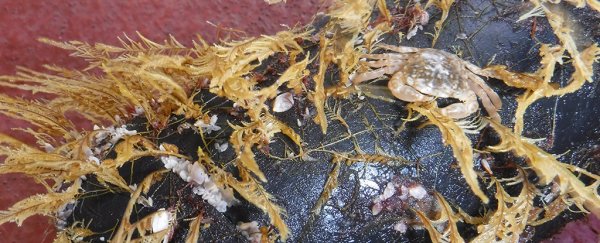The North Pacific Subtropical Gyre is home to a diffuse haze of garbage commonly known as the 'Great Pacific Garbage Patch'. Though spread across 1.6 million square kilometers (610,000 square miles) of open ocean, the patch is estimated to contain 79,000 metric tons of plastic waste.
Different ideas have been floated for how to deal with this environmental disaster. Now, scientists are starting to realise that a raft of coastal species, typically strangers to the open ocean, are beginning to colonize this new, plastic habitat.
In a new paper, lead author and marine ecologist Linsey Haram, former postdoctoral fellow at the Smithsonian Environmental Research Centre (SERC), takes stock of the marine species that have decided to call the oceanic 'garbage patch' home.
In their observations, Haram and colleagues note that a shift in the composition of oceanic invertebrate species is underway, with the emergence of an increasing diversity of coastal species that are able to occupy these plastic rafts.
Included in these communities are species of anemone, hydroids, and shrimp-like amphipods. The team calls these new communities neopelagic, neo meaning 'new' and 'pelagic' referring to the open ocean, as opposed to coastal.
Historically, oceanic invertebrate species were largely neustons – small organisms that attach themselves to the top or underside of the ocean's surface film. They also take residence on floating logs, seaweed, and other marine animals.
The arrival of these new coastal organisms has the potential to disrupt an ecosystem that is already delicate and lacking in resources.
"Coastal species are directly competing with these oceanic rafters," says Haram. "They're competing for space. They're competing for resources. And those interactions are very poorly understood."
For a while now, scientists have understood the role of 'rafts' (seeds, trees, seaweed, pumice) in the dispersal of coastal and continental species across large ocean distances. This process is even thought to be responsible for the marine iguana (Amblyrhynchus cristatus) colonization of the Galapagos, whose ancestors originally hailed from South America.
But this rafting was a transient process, due to the biodegradable nature of such objects. However, with the large-scale human introduction of plastics into the environment, plastic rafts provide a permanent opportunity for coastal species to transit ocean basins, and a long-term home to colonize on the open ocean.
The introduction of these new coastal species into the open ocean represents a paradigm shift in the understanding of marine biogeography for a couple of reasons. The vast tracts of open water have long been considered to be a physical and biological barrier for the dispersal of species, with the exception of sporadic climate events that trigger the creation of more rafting opportunities.
"This situation no longer appears to be the case, as suitable habitat now exists in the open ocean and coastal organisms can both survive at sea for years and reproduce, leading to self-sustaining coastal communities on the high seas," the authors of the paper note.
Additionally, the existence of self-sustaining coastal marine communities on the open ocean could provide these species, and other marine species, with a stepping stone environment before propagating into new coastal habitats. Haram and her colleagues see this as particularly worrying, as a host of new environments may become susceptible to invasive species.
"Those other coastlines are not just urban centers .. That opportunity extends to more remote areas, protected areas, Hawaiian Islands, national parks, marine protected areas," says senior SERC scientist Greg Ruiz, who heads the marine invasion lab.
Haram notes that many of their questions remain unanswered and that further research is required to learn more about these neopelagic ecosystems.
What is the extent of the biodiversity of coastal species persisting at sea and how often do coastal species co-occur with neustonic species on plastic rafts?
"We need to know to what extent neopelagic communities self-sustain or require continued input of rafts, propagules, and gene flow from coastlines," the authors state in the paper.
Understanding the host of abiotic factors that are likely to affect the success of coastal communities on the open ocean is also important. For example, how does a buoy that comes loose from an aquaculture facility that already plays host to numerous coastal species differ from a plastic bottle that may have been lost overboard from a fishing vessel?
One thing is for certain. As human demand and production of plastic increases (based on current trends, scientists estimate cumulative global plastic waste could reach over 25 billion metric tons by 2050), plenty of opportunities for coastal species to take their maiden voyage out to sea will continue to present themselves.
The study was published in the journal Nature Communications.
Cover image caption: Coastal podded hydroid Aglaophenia pluma, an open-ocean crab (Planes genus) and open-ocean gooseneck barnacles (Lepas genus) colonizing a piece of floating debris.
